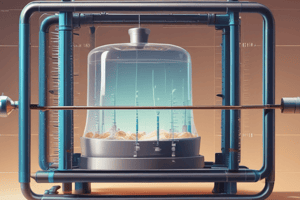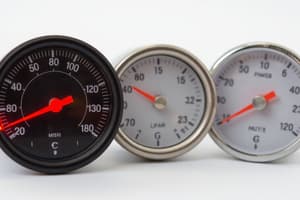Podcast
Questions and Answers
What happens to the saturated vapor pressure as temperature increases?
What happens to the saturated vapor pressure as temperature increases?
- It remains constant.
- It becomes negative.
- It decreases.
- It increases. (correct)
What is the definition of relative humidity?
What is the definition of relative humidity?
- The total pressure exerted by water vapor in the air.
- The temperature at which water vapor condenses.
- The amount of moisture in the air.
- The ratio of actual vapor pressure to the saturated vapor pressure. (correct)
Which statement accurately describes evaporation?
Which statement accurately describes evaporation?
- It involves the fastest moving molecules escaping from the liquid surface. (correct)
- It is the process where slow-moving molecules escape from a surface.
- It requires increased pressure to occur.
- It occurs only at the boiling point of a liquid.
What is the relationship between pressure and liquefaction below the critical temperature?
What is the relationship between pressure and liquefaction below the critical temperature?
Which temperature scale is NOT commonly used?
Which temperature scale is NOT commonly used?
What does the coefficient of linear expansion indicate?
What does the coefficient of linear expansion indicate?
What is Avogadro's number?
What is Avogadro's number?
What happens at the triple point of a substance?
What happens at the triple point of a substance?
What is the ideal gas law expressed mathematically?
What is the ideal gas law expressed mathematically?
How is the average kinetic energy of gas molecules related to temperature?
How is the average kinetic energy of gas molecules related to temperature?
What unique behavior does water exhibit when cooled below 4°C?
What unique behavior does water exhibit when cooled below 4°C?
What is the standard pressure measurement at STP?
What is the standard pressure measurement at STP?
In the context of the Ideal Gas Law, what measurement must always be made in kelvins?
In the context of the Ideal Gas Law, what measurement must always be made in kelvins?
What happens to the fastest molecules in an open container of water during evaporation?
What happens to the fastest molecules in an open container of water during evaporation?
According to kinetic theory, which statement about gas molecules is true?
According to kinetic theory, which statement about gas molecules is true?
What is the volume of one mole of an ideal gas at standard temperature and pressure?
What is the volume of one mole of an ideal gas at standard temperature and pressure?
What does the Zeroth Law of Thermodynamics primarily deal with?
What does the Zeroth Law of Thermodynamics primarily deal with?
Which of the following describes the process of condensation?
Which of the following describes the process of condensation?
What is the relationship between vapor pressure and temperature?
What is the relationship between vapor pressure and temperature?
What characterizes an elastic collision between gas molecules?
What characterizes an elastic collision between gas molecules?
Flashcards
Saturated Vapor Pressure
Saturated Vapor Pressure
The pressure exerted by the vapor above a liquid when evaporation and condensation are balanced.
Critical Temperature
Critical Temperature
The temperature at which a substance can exist as a gas, regardless of pressure.
Triple Point
Triple Point
The point where solid, liquid, and gas phases of a substance coexist in equilibrium.
Evaporation
Evaporation
Signup and view all the flashcards
Relative Humidity
Relative Humidity
Signup and view all the flashcards
Diffusion
Diffusion
Signup and view all the flashcards
Mole
Mole
Signup and view all the flashcards
Atomic Mass Unit (u)
Atomic Mass Unit (u)
Signup and view all the flashcards
Temperature
Temperature
Signup and view all the flashcards
Coefficient of Linear Expansion
Coefficient of Linear Expansion
Signup and view all the flashcards
Thermal Equilibrium
Thermal Equilibrium
Signup and view all the flashcards
Zeroth Law of Thermodynamics
Zeroth Law of Thermodynamics
Signup and view all the flashcards
Thermal Expansion
Thermal Expansion
Signup and view all the flashcards
Gas Laws
Gas Laws
Signup and view all the flashcards
Ideal Gas Law
Ideal Gas Law
Signup and view all the flashcards
Avogadro's Number
Avogadro's Number
Signup and view all the flashcards
Kinetic Theory
Kinetic Theory
Signup and view all the flashcards
Molecular Interpretation of Temperature
Molecular Interpretation of Temperature
Signup and view all the flashcards
Real Gases
Real Gases
Signup and view all the flashcards
Vapor Pressure
Vapor Pressure
Signup and view all the flashcards
Study Notes
Chapter 13: Temperature and Kinetic Theory
- Matter is composed of atoms. Atomic and molecular masses are measured in unified atomic mass units (u).
- 1 u = 1.6605 × 10⁻²⁷ kg
- Brownian motion is the jittery motion of tiny flecks in water, caused by collisions with individual water molecules.
- The arrangement of molecules in solids, liquids, and gases differs microscopically.
- Temperature is a measure of how hot or cold something is.
- Most materials expand when heated.
- Thermometers measure temperature using properties of matter which change with temperature; common types include liquid-in-glass thermometers and bimetallic strips.
- Temperature is commonly measured using the Fahrenheit or Celsius scales.
- The freezing point of water is 0°C (32°F), and the boiling point is 100°C (212°F).
Thermal Equilibrium and the Zeroth Law of Thermodynamics
- Two objects in thermal contact will reach the same temperature (thermal equilibrium).
- If two objects are in thermal equilibrium with a third object, they are in thermal equilibrium with each other (Zeroth Law of Thermodynamics).
- Linear expansion occurs when an object is heated.
Thermal Expansion
- The linear coefficient of expansion (a) describes how a solid's length changes with temperature.
- Volume expansion is similar to linear expansion, relevant to liquids and gases, and uses a coefficient of volume expansion (β), which relates to the fractional change in volume of gases, liquids, or solids.
- For uniform solids, β ≈ 3α. Water's behavior is unique, exhibiting a minimum volume at 4°C.
- Thermal stress can occur in materials fixed at their ends and experiencing temperature changes. The stress is related to the Young's modulus of the material and the fractional change in length.
The Gas Laws and Absolute Temperature
- The relationship between the volume, pressure, temperature, and mass of a gas is described by an equation of state.
- Boyle's Law states the volume of a gas is inversely proportional to its pressure if temperature is constant.
- Volume is linearly proportional to temperature if the pressure is constant
- The volume of a gas becomes zero at -273.15°C; this temperature is called absolute zero.
- The Kelvin scale defines absolute zero as 0 K. This scale is numerically equivalent to the Celsius scale.
- The freezing point of water is 273.15 K and the boiling point is 373.15 K.
- The pressure of a gas is directly proportional to the temperature if volume is constant.
The Ideal Gas Law
- PV/T = constant, for a given mass of gas (Ideal Gas Law).
- One mole (mol) of a substance is the mass, in grams, that equals its atomic or molecular mass. Examples given:
- 1 mol of H₂ = 2 g
- 1 mol of Ne = 20 g
- 1 mol of CO₂= 44 g
- The ideal gas law can be expressed as PV = nRT, where n is the number of moles of gas and R is the universal gas constant.
Problem Solving with the Ideal Gas Law
- Standard Temperature and Pressure (STP) is defined at T = 273 K (0°C) and P = 1.00 atm (=1.013 x 10⁵ N/m² = 101.3 kPa).
- 1 mol of an ideal gas occupies 22.4 L at STP. For unchanging amounts of gas, temperature measurements are always done in Kelvins.
Ideal Gas Law in Terms of Molecules: Avogadro's Number
- The gas constant is universal, thus the number of molecules in one mole is consistent across gases (Avogadro's number).
- NA = 6.02 × 10²³
- The number of molecules (N) is equal to the number of moles (n) times Avogadro's number (NA): N = nNA.
- Boltzmann's constant (k) serves as a link between the energy units of a molecule and the temperature.
Kinetic Theory and the Molecular Interpretation of Temperature
- Kinetic theory assumptions include a large number of molecules moving randomly with various speeds, molecules being far apart on average, obeying classical mechanics and interacting only when colliding, and collisions being perfectly elastic.
- The average translational kinetic energy of molecules in an ideal gas is directly proportional to the temperature of the gas.
- The average speed of molecules in a gas is linked to the temperature: (13-9).
Distribution of Molecular Speeds
- Graphs illustrate the distribution of molecular speeds in a gas, as described Maxwell; The most probable speed is not always equivalent to the root-mean-square (rms) speed.
- The curves shift to the right as the temperature rises.
Real Gases and Changes of Phase
- Curves in graphs show gas behavior at different temperatures, evolving away from ideal gas behavior with cooling.
- In a gas at a particular temperature (curve D), when the temperature cools, liquefaction begins at a certain pressure.
- The point (c) is called the critical point. Liquefaction can only occur below the critical temperature.
- A phase diagram shows all states of matter in the form of a plot of pressure versus temperature.
Vapor Pressure and Humidity
- Evaporation is when the fastest-moving molecules escape the liquid's surface. This is a cooling process.
- Condensation is the inverse process of evaporation.
- Saturated vapor pressure exists when evaporation and condensation are in equilibrium.
- Saturated vapor pressure increases linearly with temperature.
- A liquid boils when its saturated vapor pressure equals the external pressure.
- Partial pressure is the pressure a component of a gas mixture would exert if it were alone.
- Relative humidity is the ratio of actual vapor pressure to saturated vapor pressure at a given temperature. Relative humidity is a measure of how much moisture is in the air at a given temperature.
- High humidity feels muggy due to difficulty in further water evaporation. Dew point is the temperature at which air becomes saturated with water; conditions below the dew point lead to dew, fog, or rain.
Diffusion
- Diffusion is the process where a substance spreads out from higher to lower concentration, even without stirring.
- Diffusion rate depends on the substance and the diffusion constant (D) that links the spread to concentration, gradients, and time.
Studying That Suits You
Use AI to generate personalized quizzes and flashcards to suit your learning preferences.




